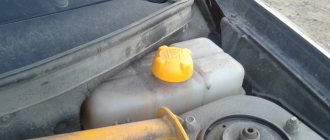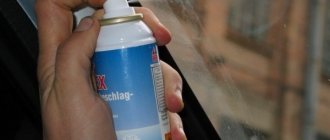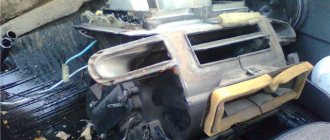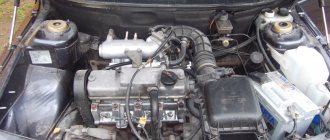- home
- Coolant
- …
Over time, instead of the usual blue, green, red (sometimes yellow) color, an incomprehensible dark liquid suddenly forms in the expansion tank of your car. Usually either black or dark brown. Moreover, this sometimes happens after replacing the coolant. So why does this happen? Why does antifreeze turn dark over time or immediately (after a couple of weeks)? Is it possible to drive or do you need to change it immediately - let’s look at the main reasons...
To begin with, I would like to say that antifreeze or antifreeze is not filled in for the entire service life of your car; after a certain mileage it definitely needs to be changed and you should not neglect these recommendations. Any manufacturer has this written in the operating instructions, usually about 40 - 60,000 km, rarely after 90 - 100,000 km. This run-up is characterized by various additives and the composition of coolants (currently there are classes G11, G12, G13). Accordingly, G13 will run the longest.
What to do?
To begin with, for serious malfunctions - if there is a white emulsion, or there is motor oil in the tank, usually in the form of drops or clots, then you need to look towards the gasket - change it if necessary. I will say this, it happens when the engine is “halved” (the head is removed) that engine oil can get into the cooling channels, and then an emulsion will form. Here you just need to flush the system and replace antifreeze or antifreeze, if the symptoms do not recur, then it was just brought in during disassembly and there is no need to worry. On some engines it may pass through the heat exchanger gasket (for example, ECOTEC engines), it also needs to be changed.
If your antifreeze has darkened only due to time (lost its properties), then you just need to replace it.
However, it is important to remember - the system MUST BE flushed! Moreover, if there are brown deposits, rinse several times. Until clean water flows. For this process, distilled water is used, as well as special products, for example “ TRILON B ”, or simply “citric acid”.
After this, the system is clean and ready for normal operation.
How often to change antifreeze
When a driver notices that his antifreeze has turned brown, he may decide to replace it, considering that its service life has expired.
In fact, this is not always the case, and antifreeze should be changed depending on the mileage of the car, and not on its color. Different car manufacturers recommend different antifreeze change intervals. On average, it is customary to change the coolant every 40-60 thousand kilometers, but on some cars the replacement period can reach up to 90-100 thousand kilometers.
Please note: The frequency of antifreeze changes depends not only on the car, but also on the liquid itself. Antifreeze can be of various classes, now the most common are G11, G12, G13
Coolant class G13 retains its properties for the longest possible time, thanks to the use of higher quality additives.
Why does antifreeze darken in the expansion tank of a car and what to do about it
Antifreeze or antifreeze is of great importance in engine operation, since this liquid is directly involved in cooling a running engine. The cooling system consists of 2 circuits through which antifreeze circulates.
Coolant is poured through the filler neck of the expansion tank, most often located in the engine compartment. It happens that a motorist notices a change in color. Moreover, the liquid can become transparent, change its original color, or even darken.
Any change indicates the presence of certain problems, and also acts as a compelling reason for the next replacement. You need to understand why the antifreeze has darkened, eliminate the cause, and then perform a full replacement procedure.
Prepare for the fact that the coolant will lose its characteristics and properties before the regulated period. It also happens that darkening occurs literally immediately after replacement. There are reasons for this, writes Avto.ru.
Why does the smell and color change?
Experienced motorists probably know why the antifreeze circulating through the cooling system darkens in the expansion tank.
Over time, inside the tank, where liquid of a certain shade is usually observed, a liquid of a completely different color with a clearly unpleasant odor can form. Any change in color or odor should not be considered normal.
Typically, antifreeze or antifreeze turns brown or dark. Much less common phenomena such as foaming, darkening of the main shade, and the appearance of flakes are observed. Moreover, this can be observed literally a few weeks after the replacement was carried out.
It is important to understand why and for what reasons the antifreeze in the engine cooling system suddenly darkens, what causes this and how to correct the current situation.
No change in color or smell should be ignored. It is possible that the liquid has simply reached the end of its service life. This is one of the possible reasons why the antifreeze in the tank darkens and changes its characteristics. In this case, a kind of transformation is observed. Initially, blue antifreeze becomes green, and then may turn out to be completely transparent. It also happens that the coolant turns yellow and then loses color.
Regardless of the specific color changes, the loss of the original color indicates that the liquid is no longer suitable for use and needs to be replaced. In parallel with the color change, the smell usually changes. It becomes pronounced and unpleasant.
But there are also more probable reasons why the antifreeze in the expansion tank suddenly and prematurely darkened. You should not focus only on darkening. In addition to the fact that antifreeze can turn black, it also loses its color, and this is also considered a deviation from the norm.
Let's look at the main possible reasons.
- Metal surfaces through which coolant passes oxidize. Usually found on cars with high mileage. Corrosion and rust appear on these metal elements. It mixes with the coolant and begins to circulate throughout the system. Hence the color change.
- Poor quality antifreeze is used. The liquid does not have the required quality and characteristics and does not contain restraining additives. An overly aggressive composition can corrode rubber seals, hoses and pipes. In fact, by dissolving these elements, their particles mix with the coolant, and it becomes dark, actively blackening.
- Instead of a special coolant, ordinary water is filled in. Yes, in extreme cases you can add distilled water. But if we are talking about ordinary tap water, then expect a clear change in the near future. The coolant may become cloudier as scale builds up in the radiators.
- Antifreeze has lost its properties and changed color. Each coolant contains a complex of additives that have a limited service life. If the additives stop functioning, the antifreeze will no longer be able to respond normally to elevated temperatures. Sometimes even when heated to 90 degrees Celsius, foaming occurs, the smell becomes pungent, and the color changes.
- Coolant mixed with engine oil. During normal engine operation, antifreeze and oil should not come into contact with each other or mix in any way. But if oil gets into the antifreeze, it will immediately darken and change the smell. This mainly happens when the cylinder head seal is broken, that is, the gasket breaks.
- Additives are poured into the radiator. There is a category of motorists who are confident in the incredible effectiveness of additives that can eliminate leaks in the radiator. Their effectiveness is almost zero. But they have a very good effect on color changes. The smell also changes and beneficial properties are lost. The consequences of using additives can be more serious.
- The antifreeze was changed, but the system itself had not been flushed for a long time. Because of this, quite a lot of deposits have accumulated inside. When pouring in fresh coolant, old dirt mixes with it, and the antifreeze quickly darkens and becomes cloudy.
- The cooling system has failed, or there are problems with the oil heat exchanger. The latter is found on modern cars equipped with powerful engines. If antifreeze turns black, there is a high probability that this is the reason.
Don't be surprised if the coolant turns out to be red in color. This is a clear sign of corrosion within the system.
How to solve a problem
The first step is to understand why the antifreeze suddenly turned brown or noticeably darkened; there are foreign impurities inside it.
If the coolant has not been changed for a long time, there is a high probability that the antifreeze has simply used up its resource and needs a scheduled replacement.
But if you notice black antifreeze or antifreeze, which began to turn black just recently, it has changed its color and has a strong unpleasant odor, which is simultaneously accompanied by overheating of the engine, try to replace the coolant as quickly as possible.
Based on the reasons discussed, we can roughly establish what exactly happened in the cooling system. Here it is important to eliminate the root cause of the change in coolant characteristics.
If such changes occur, the system should be thoroughly flushed and the coolant replaced. To do this, it is recommended to follow the following sequence:
- first, all existing antifreeze is drained from the system;
- it is recommended to dismantle the expansion tank and wash it;
- distillate is poured into the radiator;
- then you need to drive literally 5 km with the distillate, and then drain it;
- repeat the same procedure several more times;
- Fill the system with fresh coolant that meets the requirements of your engine.
If, when draining, you notice that the antifreeze has a white emulsion on its surface, and there are traces of engine oil in the tank, the seals have clearly come to an end. You will have to carry out more complex dismantling work and replace worn parts.
Flushing agents
Since the system, including the radiator, needs to be flushed, this will require the appropriate means.
They can be made at home using improvised materials:
- Citric acid and water.
With an average level of pollution, 30 grams of acid per 1 liter of water is sufficient. But as the complexity of the clogs increases, the amount of acid can be increased. - Acetic acid.
500 ml of vinegar requires 10 liters of water. - Soda.
These are drinks like Coca-Cola, Fanta, etc. They will be expensive, but they have proven to be highly effective in practice. This is what you and I drink, it turns out. - Milk return
It is poured inside the radiator and then washed with water. - Caustic soda.
It can be replaced with sodium hydroxide. An excellent remedy against contamination in copper radiators. But aluminum units should not be washed under any circumstances.
As you can see, there are really a lot of options.
Consequences of failure to replace
As it is used, the coolant loses its properties and ceases to be effective. Its further circulation within the system brings more problems than benefits.
Due to old and worn-out coolant, the cooling system is subjected to very serious loads, and the engine overheats. This leads to all sorts of malfunctions, some of which may well result in a major overhaul.
If you do not change the coolant, you will simply destroy your own engine with your own hands.
Why does darkening occur immediately after replacement?
It would seem that the motorist drained the old coolant and eliminated the reasons why the antifreeze noticeably darkened in the expansion tank. But a little time passed after the replacement, and the color changed again to an uncharacteristic one.
There are 2 possible reasons for this phenomenon:
- The problems that caused changes in the color, smell and characteristics of the coolant were not corrected. That is, the driver simply changed the antifreeze without thinking about why such changes occurred. If the cause is not eliminated, each subsequent portion of new antifreeze added will also darken.
- The driver forgot to flush. Or he didn’t consider it necessary to carry it out. The remaining contaminants are mixed with the fresh coolant, and hence the changes in color and smell.
All that remains is to understand which situation concerns you specifically and correct the mistake you made. What you definitely shouldn’t do is ignore any changes associated with the coolant.
If you find an error, please select a piece of text and press Ctrl+Enter .
Share
What antifreezes are ethylene glycol used in?
Now there are generally accepted standards, these are antifreezes G11 (G11+), G12 (G12+, G12++), and in our antifreezes (in fact, they belong to the G11 family). If you sort it by color, it is blue, green, red.
Now in more detail:
Safety. Ethylene glycol is a toxic liquid that can poison a person not only when ingested, but also through the pores of the skin and when inhaled! Therefore, they are now trying to reduce its use. It is worth noting that if a person remains in a room where this liquid has been spilled for a couple of hours, it can cause severe poisoning. And if it gets inside, it will lead to death in 60 - 70% of cases.
Temperature threshold. Do you know that pure ethylene glycol freezes at -12 degrees. However, if you break it up with water, you can reach temperatures of -40 to -50 degrees. Find out how to properly dilute such concentrates here.
Corrosion resistance. It should be noted that it corrodes almost all types of materials, metals (cast iron, aluminum, brass, copper, etc.), rubber. Therefore, the concentration of additives must always be sufficient.
Flammable Fires of antifreeze based on it are often possible, especially when water evaporates. So if there is only 15% water left, then it can simply catch fire. If the water level is 40%, then popping sounds are possible. So the water level should always be normal.
Now it is practically prohibited, in many European countries, here in Russia, as well as in neighboring countries - ALLOWED. Therefore, you need to handle antifreezes based on it very carefully; storing it at home is not recommended! Open storage is not recommended! Poisoning and even fire are possible. The time of ethylene glycol is passing, it is outdated and does not meet all the characteristics currently required.
Causes of darkening
There are not many of them, but they all reflect important problems. Moreover, sometimes the antifreeze is brown, sometimes black (sometimes with flakes), but sometimes it also foams.
- The deadline has passed . As I already wrote above, it gets dark because the additives (base) simply stop working. Plaque and sediment may form inside
- Oxidation of the walls inside . Based on the first point, it can be understood that the protection of metal parts no longer occurs as needed; the walls begin to oxidize. Rust appears and that's why it turns brown
- Rubber parts . Again, we look at point “1”, antifreezes (antifreezes) are active substances, if they do not contain additives (which restrain their ardor), then they can destroy the walls of hoses, pipes and other things. Moreover, in this process a blackish tint is formed
- Boiling. Because the additives have stopped working, boiling inside the system is possible; of course, all this can go into the expansion tank. The whole point is that normally working antifreeze can withstand temperatures of 120 degrees, and already worn-out antifreeze will begin to form bubbles at 90. This negatively affects the fluid as a whole (including its color) and the condition of the engine.
- Tap water. On a long journey, it happens that the system leaks, for example, a hose bursts. You eliminate it, but the “cooler” you need is not nearby (to complete the level)! You pour regular tap water or from a mineral water bottle. But this water is not intended for the system; it will leave scale on the walls. Again, the formation of a brown tint is possible.
- Engine oil. Sometimes oil gets into the cooling system, either through the heat exchangers or through the head gasket. It gives a dark color
- Additives. Adding all sorts of miracle products to the radiator (for example, to eliminate a leak). No matter what anyone says, they also don’t understand how they react to antifreeze or “TOSOL”; the color will most likely change after their use.
- White deposits (emulsion flakes) on the lid or walls of the expansion tank. Well, and lastly, a white coating sometimes forms (although the liquid itself is of a normal shade), sometimes in the form of flakes, sometimes just in the form of a film. This is engine oil getting into the system, either during repairs, or the head gasket is broken. You can’t delay repairs, you need to fix them
In any case, if the color has changed, then you need to take urgent action - REMEMBER THIS IS NOT NORMAL.
Antifreeze manufacturer's recommendations
Each country involved in the automotive industry produces coolants based on its own accepted standards. Only such antifreeze is also exported. That’s why there is such a rich assortment of cooling system fluids on the shelves of car dealerships, of different brands, with their own characteristics and service life.
In order to somehow streamline the current situation, antifreeze manufacturers themselves began to use for their products the classification used by the Volkswagen concern, which divided liquids into three classes with their own recommended replacement periods: G11, G12, G13.











